The outpouring of testimony from women who have experienced harassment has been immensely powerful. But it‚Äôs not just happening in Hollywood. To find out the extent of the problem in construction, ∫⁄∂¥…Á«¯ commissioned Hays Recruitment to carry out a wide-ranging survey on gender issues ‚Äì the results make for disturbing reading.

Survey methodology and key findings
Gender pay gap reporting in construction
The fallout from the alleged behaviour of Hollywood producer Harvey Weinstein has made crystal clear what many women have to endure in many different workplaces. The #MeToo social media campaign, under which women have recounted tales of the sexual harrassment and discrimination they have suffered, has revealed – largely to men – what many women have long known about their experiences in and out of the workplace.
Now a wide-ranging survey, conducted by recruitment consultant Hays for ∫⁄∂¥…Á«¯ magazine, has laid bare the extent of this problem in the UK construction and engineering industries. Answered by more than 600 women and 300 men in the industry, it paints a stark picture of an industry struggling with the problems highlighted by the #MeToo campaign. And while it found a number of positives ‚Äì women had much higher career aspirations and were more likely to feel secure in their job than men ‚Äì there is no escaping the fact a majority of women responding had experienced harassment, victimisation and sexual discrimination, at a rate far higher than men. At the same time, just one in five women think they are paid equally to male colleagues, and continue to feel that they have to sacrifice their careers if they want to have children. So, what exactly do the findings tell us about the state of the industry, the kind of environment it creates for women entering the sector, and what can be done about this problem?
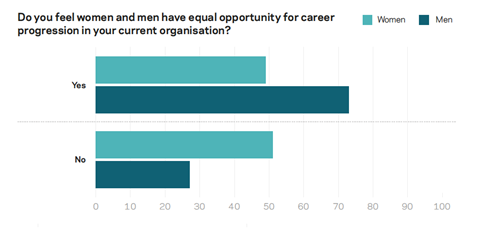
Sexual harassment
It is hard to think of a more powerful and assured woman in the construction industry today than Ann Bentley, chief executive of consultant Rider Levett Bucknall (RLB) and a member of the government’s Construction Leadership Council. But she, like many other women in construction according to the survey, has faced numerous examples of unwelcome propositions by (then) more senior male colleagues. She recalls three instances from earlier in her career – one by a man in his sixties when she was in her early twenties – the first two of which she didn’t then have the confidence to report. The last one – from a man in another firm whom she gave a lift to after a meeting – was the final straw. “I was driving,” she says, “and he was being really, really unpleasant and trying to kiss me. It was horrible, utterly, utterly awful. Eventually I parked in a public place and swore at him and told him to get out the car, which he did.”
"When you tell most well-meaning men about this kind of thing, they’re […] staggered. they say ‘no, no, this doesn’t happen any more’. Women know it does"
Ann Bentley, Rider Levett Bucknall
From Hays’ survey, conducted in November last year, it appears Bentley’s experience is commonplace. It found that 56% of women had experienced harassment or victimisation in their career, compared with just over a third of men (36%) (see charts overleaf). In addition, 55% of women said they had experienced sexual discrimination, nearly four times the proportion of men that had done. Even more shocking is when this harassment and discrimination happened. Quashing any assumptions that these figures reflect a historic problem, nearly a third (29%) of women who report experiencing harassment or victimisation said it happened during the past year. The figure is even higher (31%) for sexual discrimination. RLB’s Bentley is not shocked by the findings. “When you tell most well-meaning men about this kind of thing, they’re absolutely staggered; they say ‘No, no, this doesn’t happen any more’. Women know it does. It only takes a very small number of harassers to have this impact.”
While Bentley does agree that the industry has improved as an environment to work for women in recent years – 30% of RLB’s workforce are female – parts of the industry lag behind. “It’s definitely improved,” she says, “and on the professional side there are more and more women involved. But I’ve seen almost no change at all in site offices. The trade side is appallingly bad.”
Sarah Peers, vice-president of the Women’s Engineering Society (WES), says this sense that things used to be much worse can be used as an excuse for firms to avoid action today. “Even 30 years ago people used to say that things were so much worse in the past. It takes so long for culture to change. When we keep saying that 10 years ago this or that happened, there’s a good chance that a lot of that culture is still here.”
Richard Gelder, UK built environment director at Hays, says: “This survey appears to show that steps really need to be put in place to address this issue. The light is being shone on it now, and yes, it might have been more prevalent in the past, but it hasn’t gone away.”
Certainly, there is no shortage of anecdotes of women facing sexism in different forms, with the Huffington Post earlier this year reporting on the social media protest of a female electrician greeted on site by colleagues with “Who hired a stripper?” WES’ Peers relays the tale of a “tough alpha female” electrician who recently quit the profession completely after being publicly humiliated by her supervisor on site – run by a large major contractor – for leaving tampons at the back of drawers provided for personal items. Peers says: “It was against a background of general harassment, but she always gave as good as she got. The supervisor told her he didn’t want to see her ‘fucking disgusting sexual things’ in the site office. When the site manager who witnessed this didn’t back her up in public, this really was the last straw as far as she was concerned. She has just left the construction industry.”
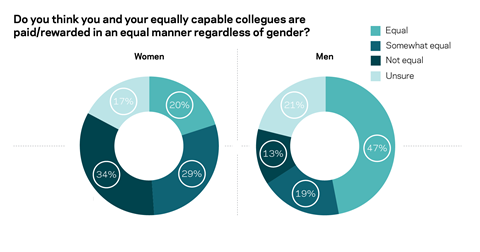
Of course, women don’t have to face overt harassment or victimisation for the workplace to become an uncomfortable place. Bentley says: “There’s the day-to-day sexism which is often about language – saying “Thanks, darling” – this language is really pervasive even with really well-intentioned people. On site it’s worse, it’s more unpleasant, sexually based. And then there’s overt harassment, touching. At one end of the spectrum it’s a shame, at the other end it’s breaking the law.”
Peers says many construction businesses just don’t register some of the less severe issues as a problem at all. “There are small companies that you go into that still have girlie posters on the wall and then complain about the fact women don’t want to work there. They really don’t see it.” Likewise, the organiser of trade show UK Construction Week was last year forced to apologise after allowing a stand with four women dressed as Las Vegas showgirls.
"There are small companies that […]have girlie posters on the wall and then complain […]women don’t want to work there"
Sarah Peers, WES
However, it’s not clear how far, if at all, construction lags behind other sectors. A recent poll by the Trades Union Congress found half of female workers across all industries had experienced unwanted sexual behaviour at work, a very similar proportion to that found in our survey. And there is some optimism that the current media focus on sexual harassment gives an opportunity to improve things.
Theresa Mohammed, a construction partner at law firm Trowers & Hamlins, and chair of the National Association for Women in Construction (NAWIC), says: “These figures are terrible. This kind of behaviour is not acceptable in our sector and is something we actively oppose. We’ve seen a huge public backlash against harassment in recent months and the mood across all sectors is that men and women are not prepared to stand for it.”
Key to this, most agree, is the need for women to feel confident in reporting harassment, with a #MeToo style forum for women in construction to tell their stories also mooted by Mohammed. Sue Kershaw, now managing director for infrastructure project and programme management at KPMG, didn’t report her first construction boss 25 years ago, when he told her he hated women, and hated women engineers even more. “I was so glad to have a job, and there was no one to report it to,” she says.
But the industry is now much more welcoming to women than it’s ever been, she says. “It was a very different time. You’ve got to call this behaviour out and generally people just stop in their tracks as they realise what hot water they’re getting into. Now women can call this behaviour out with confidence,” she says. RLB’s Bentley, too, says that in her experience when she or others have reported harassment, it has been acted upon and taken very seriously. NAWIC’s Mohammed says: “One positive aspect of what’s happened after Weinstein is that people feel empowered to speak up.”
"These figures are terrible. […] We’ve seen a huge public backlash against harassment in recent months and the mood across all sectors is that men and women are not prepared to stand for it"
Theresa Mohammed, Trowers & Hamlins
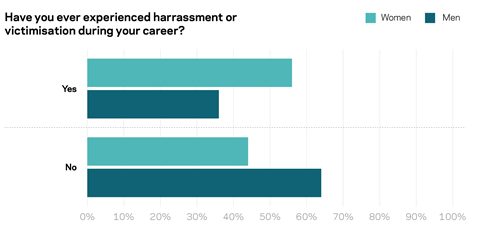
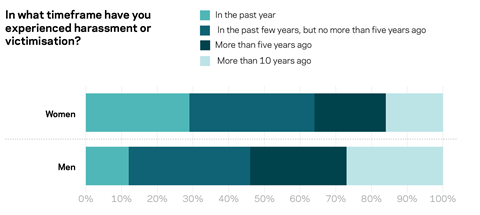
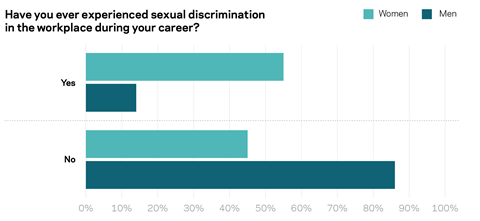
The pay gap
It is not only the findings around harassment and discrimination in the survey that are discouraging. Only 20% of women feel there is equal pay between genders at their firms, compared with nearly half of men (see charts page 32). Bentley says: “This is hugely disappointing. And it could be a really significant factor in terms of women leaving their careers in construction. It might be as simple as they’re leaving because they feel they’re not being [properly] remunerated.”
These findings are supported by government data showing pay gaps of anything up to 44% in various construction occupations (see Women in construction: the facts, page 32). There is scepticism too as to whether the proposed compulsory gender pay gap reporting for firms employing more than 250 staff will make much difference.
At the same time, the survey finds nine out of 10 women in construction believe that having children harms their career prospects either a little or very much, and that while the majority of men go back to work after having children to the same job and the same hours, less than a quarter of women are able to do so (see graphs above).
The project by project nature of construction is seen as putting a barrier in the way of more flexible forms of working better suited to parents. Hays’ Gelder says: “It’s often not about specific policies but about what’s not said. There’s been a bit of a cultural problem with flexible working – many employers know they have to do it but don’t really want to. It requires them to lose the idea that they can only deliver by everyone working all the hours god sends.”
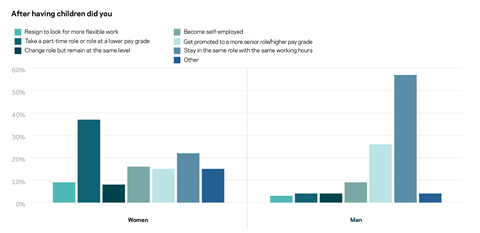
Work in progress
Counteracting all this bad news, however, is a strong sense that the industry is, finally, changing fast. Kier is one contractor making efforts to address these problems, teaming up with the Women’s Engineering Society to set up a returners programme for employees who have been out of the workplace for some time, often after having a family (see panel on page 33), which it is promoting on websites such as workingmums.com and Mumsnet.
And harassment is, of course, not every woman’s experience of construction. WSP’s head of structures, Jane Richards, says her team now brings in equal numbers of men and women at graduate level, something that has transformed the feel of the workplace over the last decade. Even on site, she says, being a woman has never been a problem. “I did a year’s placement on site, during which time I was pregnant, but it was never an issue; there were no comments,” she says. Likewise, Theresa Mohammed says all the construction companies she works with at Trowers & Hamlins have “very sophisticated policies” allowing staff to report wrongdoing anonymously and ensure it is investigated: “Our clients are developers, contractors and subcontractors, and in my experience on site they all go out of their way to be respectful.”
"There’s been a bit of a cultural problem with flexible working – many employers know they have to do it but […] It requires them to lose the idea that they can only deliver by everyone working all the hours God sends"
Richard Gelder, Hays
All those interviewed for this piece said their firms – Kier, WSP and RLB – give staff training in unconscious bias to avoid managers recruiting in their own image. WSP’s Richards says: “When people take time out of their career, we talk to them about their return and how we can be flexible. We find a work pattern that suits.” She points out that male parents have taken advantage of the policies, too.
Gelder says: “There has been an enormous amount of work done on this issue in the last year, a huge move to get to grips with diversity, led both by professional institutions and by companies themselves.
“You’re seeing people appointed in roles to drive the inclusivity agenda, and these are people with the clout to get things done. It’s driven now at organisational level by the main board and the senior management – something that simply wasn’t in place a couple of years ago.”
For Bentley, though, more work is still needed, starting with addressing really practical issues such as ensuring the availability of personal protective equipment on site in sizes that will fit women, and the stamping out of “everyday sexism” on site in the same way that the Considerate Constructors programme has largely stopped wolf-whistling to passers-by on the street. “On harassment, there needs to be visible sanctions and reporting mechanisms, and telling people it’s their responsibility to report these things.” Only when those things are in place, she says, can construction start telling a positive story about the great career opportunities the industry can offer women.
Women in construction: the facts
According to the Office for National Statistics (ONS), women make up 13.5% of the construction workforce – less than 1% higher than 20 years ago, when it was 12.8%. On further examination, even this figure may be an exaggeration. The number covers all those who work in construction firms – whether their occupations be bricklaying, surveying, accountancy or HR. If you examine the gender split of the 2.4 million people actually in construction occupations – whether they be managers, tradesmen or professionals – just 6.5% (161,000) are women. This implies about half the women said to work in construction are, in reality, engaged in the corporate functions of construction businesses, not in actual construction jobs. This varies by occupation, with the data suggesting about 30% of architects are female, while the numbers of women in most individual trades, such as plastering and bricklaying, are so small the ONS records no figures.
Government data also suggests a big pay gap between men and women in construction – although here the ONS says the data is a “best guess” rather than an absolute figure. Figures for 2016 reported a median pay gap of 21% in skilled construction trades overall, with some specific occupations much higher, such as construction and building trades supervisors, where a 44% gap was found. These figures do not purport to compare directly equivalent roles, so could be either an indicator of men having a greater seniority in these job roles, or of them being paid more for the exact equivalent job, or both.
Kier STEM Returners
Contractor Kier has just commenced piloting a “returnship” scheme in partnership with the Women’s Engineering Society’s (WES) STEM returners programme, working across different industries. STEM is short for science, technology, engineering and maths.
Jan Atkinson, talent and organisational development director at Kier, says the firm realised it lacked a route for people who had left construction to come back following a career break, including after having a family. In the pilot, the organisation is giving 10 people a bespoke 13-week package to help them get back to work, including job shadowing and mentoring within and outside Kier, all designed around the role they want to have.
“We want a culture of innovation in Kier; we need people that think differently, and that means diversifying our working population,” says Atkinson. While not specifically a measure designed to address the firm’s gender imbalance (its target is to achieve
a 70/30 male/female split, from a current split of 77/23), this drive to diversify led it to engage with WES, as well as advertise on social media and websites such as workingmums.com and Mumsnet.
Sarah Peers, vice-president of WES, says: “Some companies have started to be really proactive, realising they need to do something. We’ve noticed that some construction companies have been first in line to get involved. Kier approached us before they knew of this programme; we need to celebrate companies like that.”



























No comments yet